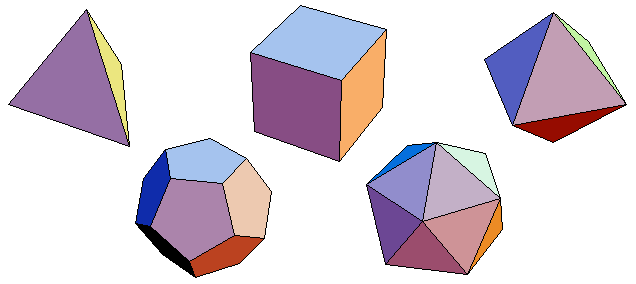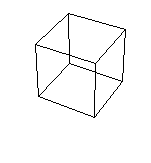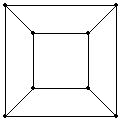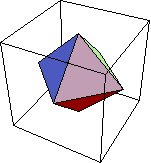
| Contents |
Supplements and Links
|
| Objectives: To develop spatial reasoning, specifically by applying techniques of planar geometry to three-dimensional solids. | Necessary Background: Experience with plane geometry is required, but no trigonometry is necessary. Section II assumes the knowledge of Euler's formula. |
| Summary: In Section I, students derive the volumes and surface areas of the five Platonic solids in terms of side length. In Section II, students apply Euler's formula to polyhedra, count the number of diagonals in each of the Platonic solids, and find the dual polyhedra of the Platonic solids. | |
As we can consider polygons in the plane, we can consider polyhedra in space. A polyhedron is a closed, three-dimensional figure whose faces are polygons. For example, any closed box is a polyhedron, for its faces are rectangles. A polyhedron is called convex if the line segment joining any two points in the interior of the figure lies completely within the figure. (Stellated ("star"-like) polyhedra such as these are not convex.) A polyhedron is called regular if all its faces are congruent and if all its vertices are identical (i.e. share the same number of faces and the angles between the faces are the same). You may find it surprising that, although there are infinitely many regular polygons, there are only five convex regular polyhedra, known as the Platonic solids after Plato, who equated them with the elements of nature. See if you can find three of them before moving on. (There are four non-convex regular polyhedra, known as the Kepler-Poinsot solids.)
Show that the cube is a regular polyhedron. What is the volume of a cube with side length s? What is the surface area of such a cube?
What is the radius a of a sphere inscribed in a cube? We'll call a the apothem. What is the radius r of a sphere circumscribed around a cube?
A tetrahedron is a polyhedron with four faces. Draw a regular tetrahedron, and show that it is a regular polyhedron. What is its surface area?
What is the height h of a regular tetrahedron with side length s? What is its volume?
The five Platonic solids are pictured below. Rotatable visualizations of the Platonic solids are provided on the Wolfram Research web site. From the top left they are the regular tetrahedron (four faces), the cube (six), the regular octahedron (eight), the regular dodecahedron (twelve), and the regular icosahedron (twenty).

What is the surface area of a regular octahedron of side length s? What is its volume?
What are the surface areas of the regular dodecahedron and the regular icosahedron?
What is the volume of the regular icosahedron? (Hint: How do we find the areas of regular polygons?)
What is the volume of the regular dodecahedron? (Hint: Break up the dodecahedron into smaller components.)
We can "squash" any polyhedron down into a two-dimensional plane without forcing any of the edges to intersect. The process is illustrated for the cube below and works similarly for any polyhedron. In the case of the cube, the result of the transformation is the cube graph, shown at the right.
 | |  |
After this transformation, the vertices of the polyhedron correspond to intersection points in the plane, edges correspond to segments, and faces correspond to regions (including the exterior "region", which also began as one of the faces of the polyhedron). We have obtained a planar graph, i.e. a graph in which no two edges cross each other. Therefore, we can apply Euler's formula for planar graphs to the polyhedron. For a polyhedron with V vertices, E edges, and F faces, Euler's formula states that V, E, and F are related by the equation V – E + F = 2.
Verify that Euler's formula holds for the cube and the tetrahedron.
Verify that Euler's formula holds for octahedra, dodecahedra, and icosahedra.
Given any polyhedron, we can find its dual polyhedron by the following process: From the center of each face of the polyhedron, draw a line segment to the center of every other face adjacent to that face. These line segments are the edges of the dual polyhedron. For example, the dual polyhedron of the cube is the regular octahedron:

What is the dual of the regular octahedron?
What is the dual of the tetrahedron?
What are the duals of the dodecahedron and the icosahedron?
A diagonal is a line segment drawn between two vertices of a polyhedron that are not adjacent to a common face. How many diagonals are there in each of the five Platonic solids? In how many points do the diagonals intersect in each?
Relevant links: